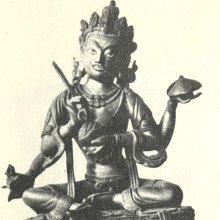Virupa, Virūpā, Virūpa: 30 definitions
Introduction:
Virupa means something in Buddhism, Pali, Hinduism, Sanskrit, Marathi, Hindi, biology. If you want to know the exact meaning, history, etymology or English translation of this term then check out the descriptions on this page. Add your comment or reference to a book if you want to contribute to this summary article.
Virupa has 30 English definitions available.
Images (photo gallery)
Languages of India and abroad
Sanskrit dictionary
[Deutsch Wörterbuch]
Source: Cologne Digital Sanskrit Dictionaries: Böhtlingk and Roth Grosses Petersburger WörterbuchVirūpa (विरूप):—1. (2. vi + rūpa) n. Missgestalt, Hässlichkeit: dhṛk [Harivaṃśa 16006.] [Kathāsaritsāgara 52, 75.]
--- OR ---
Virūpa (विरूप):—
Sanskrit, also spelled संस्कृतम् (saṃskṛtam), is an ancient language of India commonly seen as the grandmother of the Indo-European language family (even English!). Closely allied with Prakrit and Pali, Sanskrit is more exhaustive in both grammar and terms and has the most extensive collection of literature in the world, greatly surpassing its sister-languages Greek and Latin.
See also (Relevant definitions)
Starts with (+12): Virupacakshus, Virupachakshus, Virupaka, Virupakarana, Virupakkam, Virupakkha, Virupaksh, Virupaksha, Virupaksha sharman, Virupaksha-pati, Virupakshanatha, Virupakshapancakshari, Virupakshapancashat, Virupakshapancashika, Virupaksharasa, Virupakshi, Virupalasu, Virupan, Virupana, Virupanarasimha.
Ends with: Dvirupa, Prithvirupa.
Full-text (+44): Virupakarana, Virupatas, Virupaksha, Vairupya, Virua, Viruparupa, Prishadashva, Virupacakshus, Virupata, Virupashva, Virupin, Nabhahprabheda, Virupaka, Virupasharman, Virupashakti, Visamsthita, Sarupa, Virupakshapancashat, Virupi, Virupakshapancakshari.
Relevant text
Search found 36 books and stories containing Virupa, Vi-rupa, Vi-rūpa, Vi-rūpā, Virūpā, Virūpa; (plurals include: Virupas, rupas, rūpas, rūpās, Virūpās, Virūpas). You can also click to the full overview containing English textual excerpts. Below are direct links for the most relevant articles:
Rig Veda (translation and commentary) (by H. H. Wilson)
Garga Samhita (English) (by Danavir Goswami)
Verse 2.6.11 < [Chapter 6 - The Liberation of Aghāsura]
Verse 6.7.40 < [Chapter 7 - The Marriage of Śrī Rukmiṇī]
Significance of the Moon in Ancient Civilizations (by Radhakrishnan. P)
1. Viryabala of Chandra (Verility of Moon) < [Chapter 6 - Relevance of Astrology]
Manusmriti with the Commentary of Medhatithi (by Ganganatha Jha)
Verse 9.14 < [Section I - Husband and Wife]
Bhakti-rasamrta-sindhu (by Śrīla Rūpa Gosvāmī)
Verse 4.3.22 < [Part 3 - Chivalry (vīrya-rasa)]
Blue Annals (deb-ther sngon-po) (by George N. Roerich)
Chapter 6 - First incarnation series (ix): nam mkha' rgyal mtshan < [Book 8 - The famous Dakpo Kagyü (traditions)]
Chapter 2 - Date of the Kālacakra-tantra < [Book 10 - The Kālacakra]
Chapter 2 - Introduction: The Lineage of the Sādhana < [Book 14 - Great Compassion Cycle]

